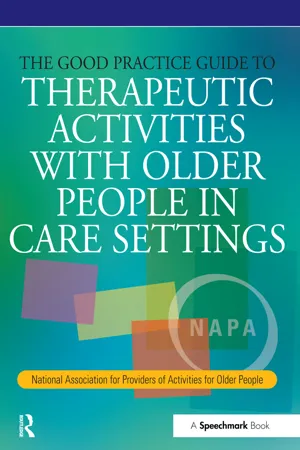
The Good Practice Guide to Therapeutic Activities with Older People in Care Settings
Tessa Perrin
- 96 pages
- English
- ePUB (adapté aux mobiles)
- Disponible sur iOS et Android
The Good Practice Guide to Therapeutic Activities with Older People in Care Settings
Tessa Perrin
À propos de ce livre
There are many activity manuals on the market today but this publication is the first to offer a clear guideline on exactly what constitutes good practice in activity provision. Written by the National Association for Providers of Activities for Older People (NAPA), a charity whose remit is to set standards and disseminate knowledge of good practice in activity provision and to support activity providers who work in care settings for older people, this guide offers: a model of good practice in one concise volume; a benchmark against which activity providers can measure and evaluate their practice; clear links to current national standards; guidance for care home owners and managers who wish to respond to the recent government initiatives on providing activities for their clients; and a call for clinical governance in the emerging 'profession' of activity provision.
Foire aux questions
Informations
Appendix 1
Sample Categories for Gathering Biographical Data
- Significant life events
- Significant events of the year
- Significant people
- Food and drink preferences
- Preferred style and size of clothing
- Preferred routines and practices for bathing
- Preferred routines and practices for rising/going to bed
- Preferences in self-care routines, such as hairdressing and manicure
- Special needs in communication
- Spirituality and religious practices
- Preferences in relation to music, television, radio, books, newspapers, entertainments
- School, family, friends and pastimes of early years
- Family, friends and pastimes of adult years
- Education, qualifications, National Service and work in adult years
- Family, friends and retirement in later years.